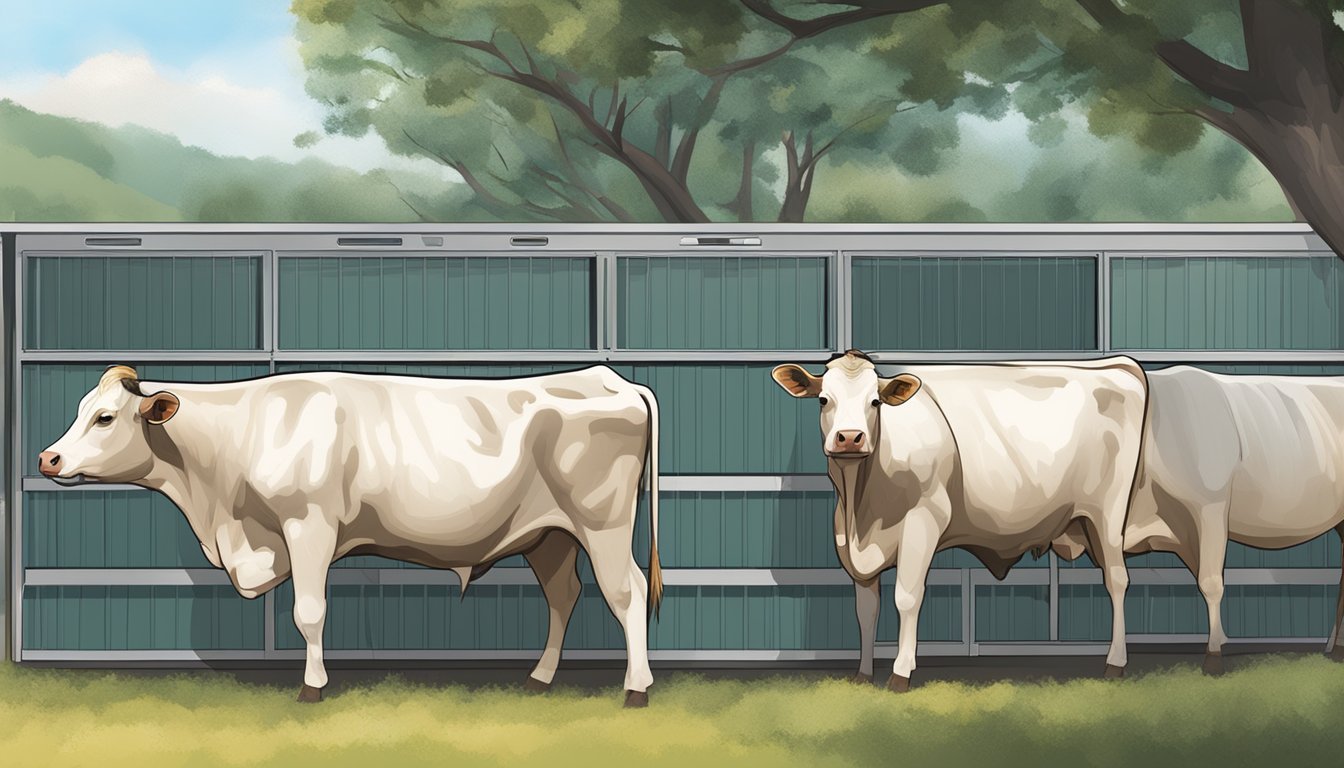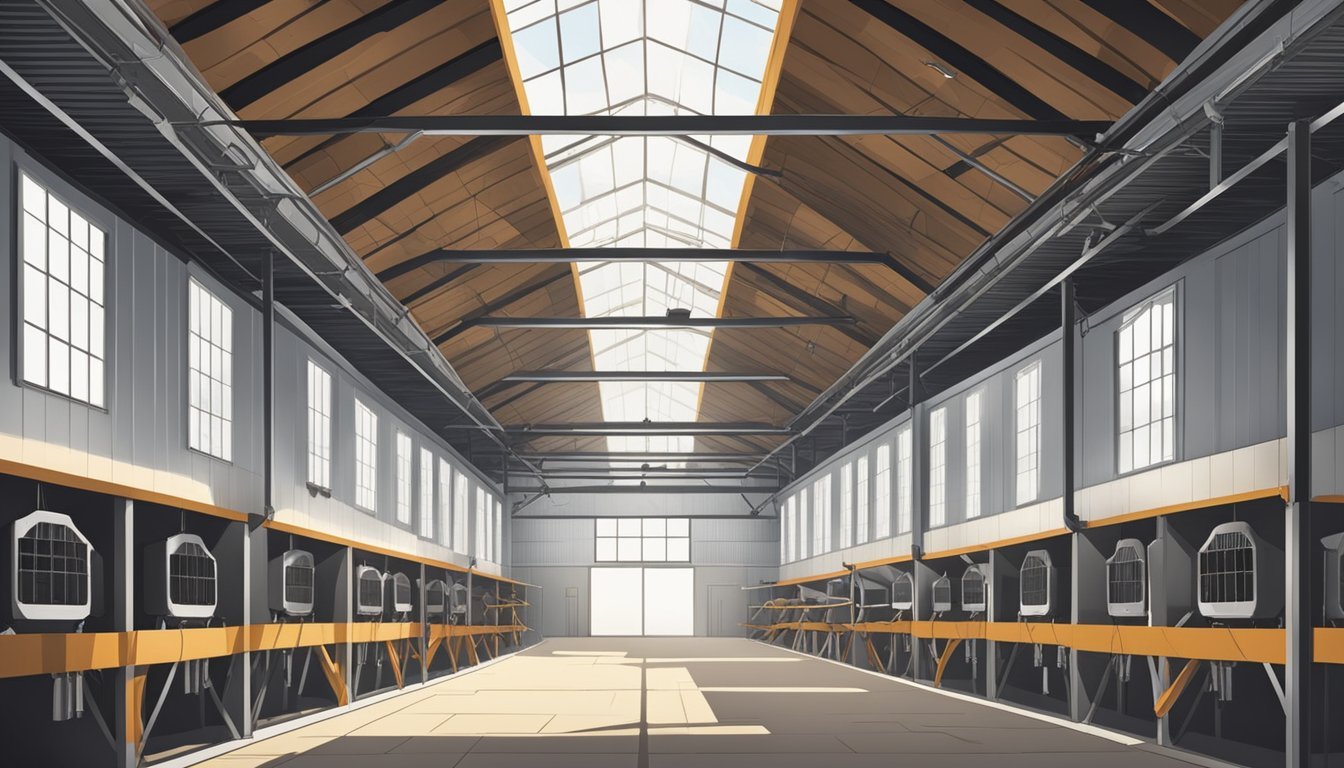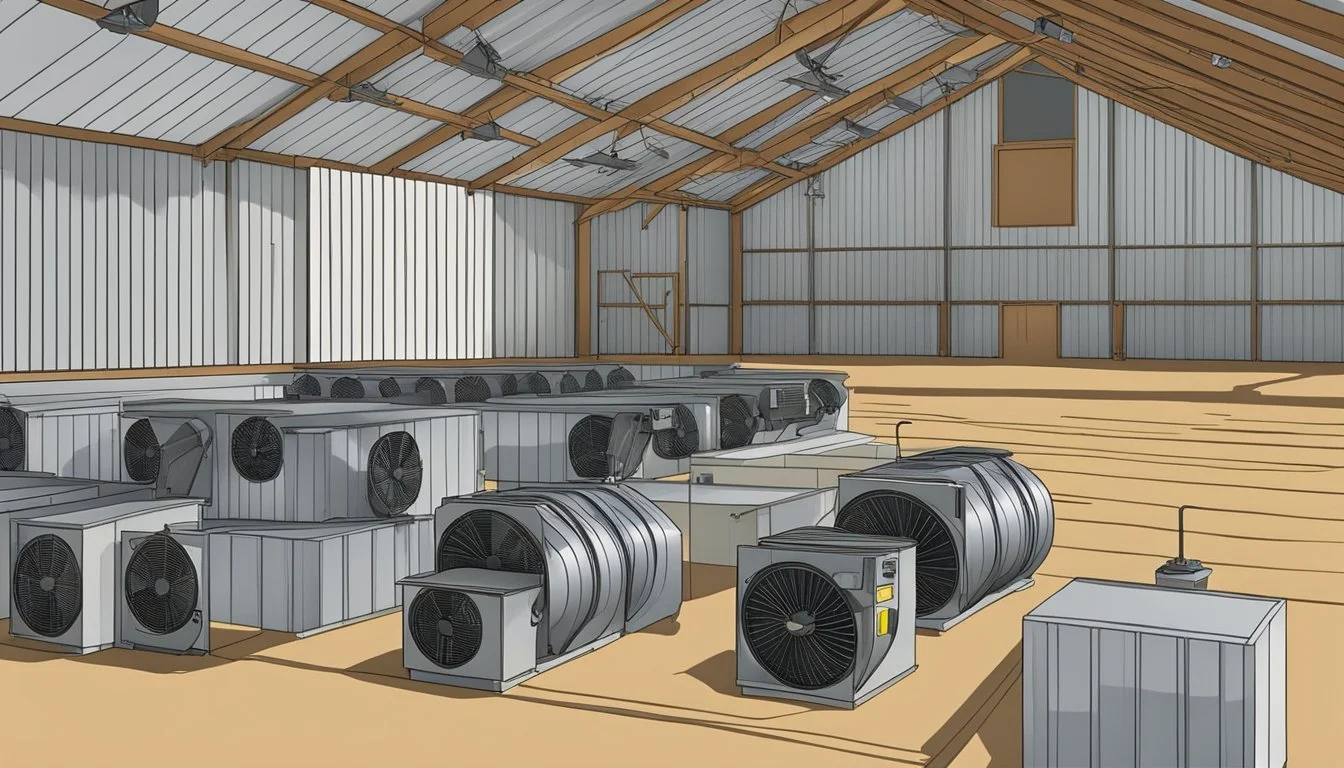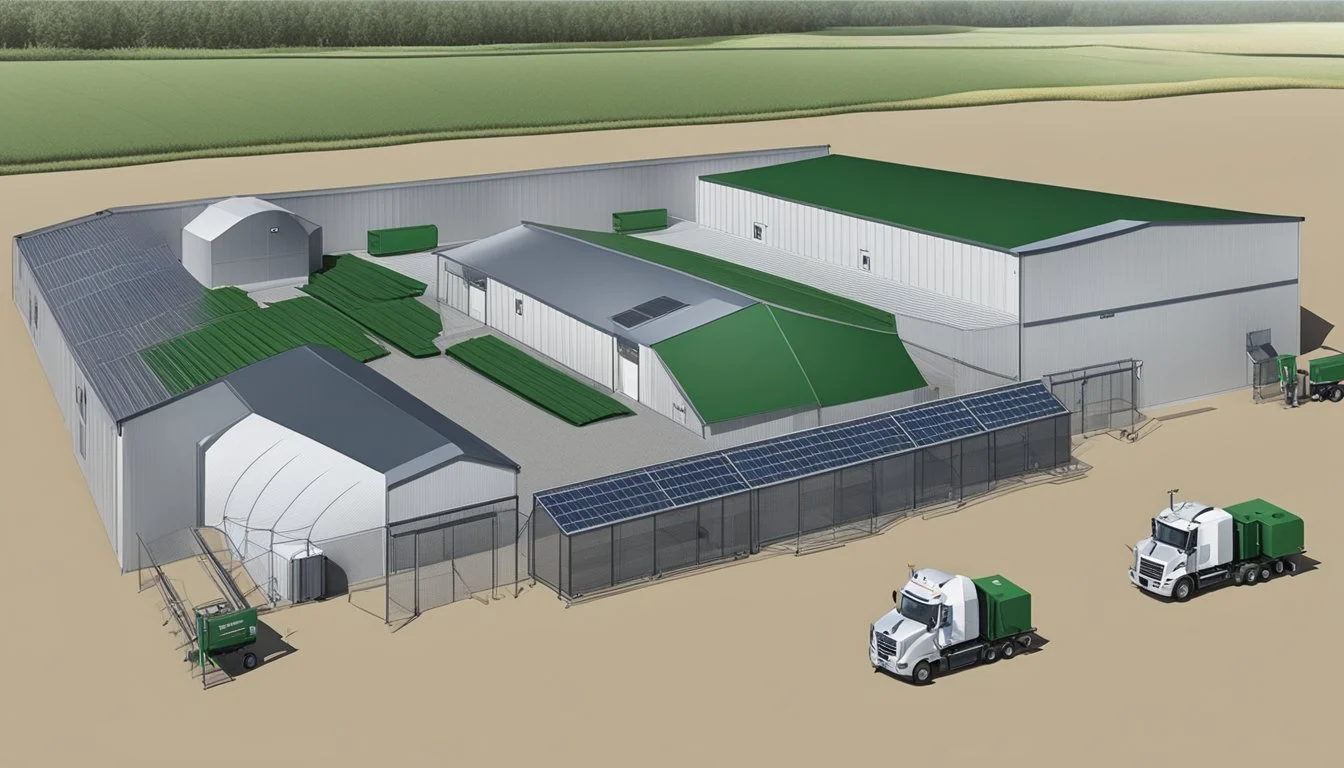How do I ensure proper ventilation in cattle housing?
Essential Strategies for Healthy Livestock Environments
Ensuring proper ventilation in cattle housing is critical to maintain a healthy environment for the livestock. Adequate ventilation provides fresh air, regulates temperature, and removes excess moisture, dust, and odors that can compromise cattle health and productivity. In addition to contributing to respiratory health, well-designed ventilation systems help prevent the buildup of harmful gases like ammonia and methane. Effective airflow reduces the risk of disease, enhances cow comfort, and can lead to improved milk production in dairy herds.
When planning the ventilation for cattle housing, it's important to consider different strategies for various seasonal challenges. For instance, during colder months, the system should allow for enough air exchange to minimize condensation without causing drafts that could chill the animals. Resources like The Cattle Site discuss how to manage and adjust ventilation openings to assure cow comfort throughout winter, as well as during summer, and transitional spring and fall periods.
For those who require controlled ventilation, mechanical systems utilizing fans, thermostats, and air inlets can ensure consistent air quality conditions. This form of mechanical ventilation is commonly found in specialized facilities such as swine farrowing and nursery buildings, indicating its applicability in settings where environmental control is paramount. Information from Penn State Extension describes how properly sized and utilized fans can optimize energy use and enhance air quality for livestock.
Basics of Ventilation in Cattle Housing
Proper ventilation in cattle housing is crucial for the health and productivity of the animals. Ventilation systems ensure that stale air is replaced by fresh air, regulating temperature and removing excess moisture, odors, and pollutants. Here are the core aspects:
Air Exchange: Critical to maintaining air quality, the system should facilitate a complete change of air within the building at least every six minutes.
Temperature Control: The systems help to maintain a consistent temperature, essential for animal comfort and health.
In livestock housing, different ventilation strategies may be utilized:
Natural Ventilation:
Relies on wind and thermal buoyancy.
Must be carefully managed to accommodate seasonal changes.
Mechanical Ventilation:
Involves fans and ducts for precise control.
Airflow capacity is measured to ensure effectiveness.
Inlets and Outlets: Position and size of these components directly affect ventilation efficiency:
Inlets: Allow fresh air entry, must be evenly spaced.
Outlets: Let out stale air, often placed opposite inlets to facilitate air movement.
It's important that the buildings are designed or retrofitted considering ventilation basics about air space availability and structural factors that influence airflow.
Fan Maintenance: Regular checks on the fans and other mechanical components ensure that the system performs optimally.
By adhering to these principles, farmers can maintain a healthy and safe environment for their livestock, which is ultimately pivotal for sustainable cattle housing.
Natural Ventilation Systems
Natural ventilation systems harness environmental elements such as wind and temperature differentials to maintain optimal air quality in cattle housing. These systems are crucial for regulating temperature and ensuring the health and productivity of the livestock.
Design Principles
For an effective natural ventilation system, key design elements are employed. Ridge openings, combined with the strategic placement of sidewall openings, facilitate air exchange through the principles of wind and buoyancy. The height and roof slope play a vital role in creating an efficient airflow path. The building’s orientation should be considered to utilize prevailing winds and minimize heat from the sun, while keeping in mind the typical weather conditions of the area. Trees and other landscaping can influence windbreak and shading effects on the building site.
Advantages of Natural Ventilation
The benefits of such a system include:
Consistent air exchange without reliance on mechanical systems, leading to lower operational costs.
Reduction in airborne pathogens and moisture, contributing to improved livestock health.
Enhanced animal comfort due to a stable internal environment which can adapt to changing external conditions.
Challenges and Solutions
Implementing a natural ventilation system can present challenges such as uneven temperature distribution and limited control during extreme weather. Solutions involve adjustable insulation materials and variable ridge and sidewall openings to manage airflow. Monitoring and manually or automatically adjusting these components can offset issues related to weather variability. Site-specific design adjustments ensure optimal performance of the system throughout the various seasons.
Mechanical Ventilation Systems
Mechanical ventilation systems are essential in cattle housing to maintain a consistent environment. They are designed to control air movement, temperature, and humidity, directly influencing the health and productivity of dairy cows.
Design and Integration
When designing a mechanical ventilation system for cattle housing, it's crucial to consider the specific needs of dairy cows. The system must integrate equipment such as fans and air inlets strategically placed to ensure even distribution of fresh air. Cattle buildings must have a ventilation rate that's adequate for the size and number of animals, as well as feeding areas to minimize the accumulation of harmful gases and control humidity levels. Precisely placed air inlets are key for effective air exchange.
Controlling Environmental Factors
Controlling environmental factors is pivotal in a mechanical ventilation system. Ventilation rates are adjusted to match the internal and external conditions; this could include thermostats, sensors, and control systems working together to optimize the indoor climate. The mechanical systems must react to changes swiftly to avoid stressing the dairy cow, ensuring that temperature and air quality are kept within the parameters conducive for animal wellbeing and productivity.
Maintenance and Operation
The longevity and efficiency of a mechanical system rely heavily on regular maintenance and proper operation. It's important to assess fan performance, check for blockages in the ventilation system, and replace or repair any faulty equipment. A well-maintained system reduces costs in the long term by decreasing energy consumption and preventing expensive breakdowns. Effective operation of the system also includes training for farm staff to adjust settings as required, ensuring the system performs optimally in all conditions.
Climate Control and Animal Comfort
Maintaining optimal climate conditions is crucial for cattle welfare and health in livestock housing. Effective temperature control regulates the barn's environment, ensuring cattle comfort and supporting consistent milk production. Producers must balance temperature, moisture, and fresh air to prevent respiratory diseases and heat stress.
Air distribution and oxygen supply must be carefully managed. Poor distribution can lead to stagnant air zones and uneven temperature, potentially causing pneumonia. A well-designed ventilation system circulates air, ensuring that water vapor and excess moisture—common culprits of condensation—are appropriately removed.
During hot weather, providing shade and increasing ventilation helps keep cattle cool. In cooler climates, preventing drafts and insulating buildings will maintain a comfortable temperature without chilling the animals.
A reliable ventilation system addresses:
Fresh Air Supply: Reducing levels of harmful gases and ensuring adequate oxygen.
Temperature Control: Keeping the barn within a comfortable range for cattle.
Moisture Removal: Preventing buildup that can lead to diseases.
Inline monitoring of environmental conditions allows for constant adjustments, making the system both reactive and proactive. This attention to detail ensures that cattle have continued access to a comfortable and health-promoting environment, irrespective of external weather patterns.
Ventilation Planning and Design
Proper ventilation in cattle housing is crucial for the health and productivity of the herd. It influences air quality, temperature control, and humidity levels. Effective design and construction can enhance cattle comfort, reduce the build-up of harmful gases, and ultimately contribute to the profitability of a livestock operation.
Construction Requirements
When constructing cattle housing, ventilation is a paramount consideration that should be integrated from the outset. Key design elements include ceiling height and ventilation openings. The recommended ceiling height for cattle sheds varies to provide adequate air exchange and to accommodate specific herd requirements. For example, higher ceilings are generally preferred in hot climates to allow for better heat dissipation.
Ventilation openings, such as ridges and eaves, should be designed to regulate airflow both in summer and winter conditions. It's essential that these openings are adjustable to maintain cow comfort across varying temperatures. Incorporating features that minimize the entry of rain or snow, while permitting air to pass, ensures that the shelter remains dry and well ventilated. The effective management of ventilation openings can significantly impact the air quality, allowing for the dilution and removal of moisture, pathogens, and dust within the housing.
Site Selection and Building Orientation
Selecting the optimal site and orienting the building properly are critical steps in designing cattle housing. The orientation of cattle sheds should be aligned with prevailing winds for maximum natural ventilation efficiency. Ideally, the long axis of the building runs east-west to minimize direct sunlight penetration and overheating during summer. This positioning utilizes the natural airflow patterns to assist in ventilation, helping to keep the cattle cool and reducing the reliance on artificial systems.
In addition to wind patterns, consideration must be given to separation from other buildings and structures. Adequate distance from nearby structures is necessary to avoid impeding natural airflow into the housing. Such strategic planning supports effective dispersal of airborne pathogens and removal of dust and odors, contributing to a healthier living environment for the cattle.
Air Quality Management
Managing air quality within cattle housing is essential for the health and well-being of the livestock. Optimal ventilation rates are crucial; they ensure adequate fresh air circulation, which helps dilute and remove harmful gases like ammonia and methane, as well as reduce odors and emissions.
Ventilation systems need to be designed to minimize the concentration of bacteria and pathogens that can lead to diseases. By maintaining a clean animal environment, the risk of respiratory issues and other health problems is significantly reduced, leading to improved productivity and potential profitability of the livestock buildings.
Here are some key considerations:
Fresh Air Supply: Ensure a continuous influx of clean air to displace and dilute pollutants.
Ventilation Rates: Adjust these according to the age and number of cattle, outside temperature, and humidity.
Regular Monitoring: Check levels of gases like ammonia and methane to avoid toxic buildup.
Factor: Fresh Air
Purpose: To maintain oxygen levels and remove excess moisture and heat.
Factor: Ventilation Rates
Purpose: To remove airborne contaminants and supply the required oxygen.
Factor: Regular Monitoring
Purpose: To keep a check on harmful gas levels and overall air quality.
Proper ventilation positively impacts cattle health, which is inextricably linked with the operation's success. It is, therefore, essential to invest in an effective air quality management plan. Implementing the right ventilation system adapted from resources like Penn State Extension can greatly enhance the livestock's environment.
Additional Considerations for Ventilation
Ensuring proper ventilation in cattle housing requires thoughtful consideration of various environmental factors, health implications, and sustainability efforts. These considerations are crucial for maintaining the wellbeing of livestock and the efficiency of farm operations.
Impact of Weather and Climate
Variations in weather conditions and climate have a direct influence on ventilation strategies. For instance, in areas with high rainfall, barn designs must protect against moisture while also ensuring adequate air flow. Conversely, in places experiencing significant sun exposure, cattle housing must balance sun control with ventilation to prevent overheating and to maintain optimal light levels for cattle health. Adapting ventilation systems based on the local climate will facilitate appropriate environment control throughout the seasons.
Incorporating Environmental Sustainability
Farmers have a responsibility to minimize the environmental impact of livestock housing. This includes addressing concerns such as methane emissions from cattle. Effective ventilation can reduce these emissions by improving air quality inside the housing. Additionally, incorporating sustainable technologies, such as solar-powered ventilation systems, can both enhance climate control and reduce reliance on non-renewable energy sources, leading to lower overall emissions.
Health and Disease Prevention
Good ventilation goes beyond providing comfort—it's essential for disease prevention. Adequate ventilation helps mitigate the spread of viruses and bacteria which can lead to respiratory diseases. Strategies like ensuring a consistent air exchange rate can significantly control the buildup of harmful pathogens. Properly designed ventilation systems support overall cattle health by preventing the accumulation of diseases, thus enabling a healthier environment for both cattle and farm workers.
Operational Aspects of Livestock Housing
The operational aspects of livestock housing encompass a range of practices essential for maintaining animal health, optimizing livestock production, and ensuring the sustainability of agricultural operations. Attention to detail in aspects such as feeding efficiency and water supply can significantly impact the overall effectiveness of animal housing.
Feeding Efficiency and Layout
The design of feeding systems within livestock housing should promote easy access to feed while minimizing waste. For cattle, a layout that allows for a smooth flow of animals to and from the feeding area is essential. Swine housing, on the other hand, benefits from feeders designed to prevent spillage. Locating waterers apart from feeders can reduce contamination and ensure a cleaner feeding area.
Feeding Troughs: Size and placement should accommodate the number of animals without overcrowding, ensuring equal access for all.
Feed Storage: Proximity to feeding areas for ease of distribution, reducing the time and labor involved in moving feed.
Water Supply and Quality Control
Water is a critical resource in animal housing, and its quality directly affects livestock health. It's important to implement a system that provides constant access to clean water.
Water Troughs/Circulation: Cleaned regularly to prevent algae growth and contamination.
Water Testing: Regular testing for pathogens and contaminants to maintain water quality standards.
By addressing these key operational aspects, one can foster an environment conducive to animal well-being and productivity within livestock housing. These systems must be adaptable to the changing needs of the animals across different seasons and growth stages.
Ventilation System Choices and Economic Aspects
The correct ventilation system in cattle housing is crucial for animal welfare and can have significant economic implications. This section will compare different systems, analyze cost-efficiency and return on investment, and consider the long-term benefits related to animal welfare.
Comparing Ventilation Types
Natural ventilation systems utilize wind and buoyancy to facilitate air exchange and are often equipped with manually operated curtains to control airflow. They are suited to regions with appropriate climate conditions and require less capital compared to mechanical ventilation systems, which rely on fans and automated controls to maintain air quality, and are essential for controlled environments. Both systems have their use cases, but the decision often hinges on climate, herd size, and the specific needs of the cattle.
Evaluating Cost Efficiency and ROI
Initial investment in ventilation equipment and ongoing operational costs such as energy usage for mechanical systems must be weighed against the expected lifespan of the equipment and profitability gains from improved cattle health and production. Producers should analyze these costs in a comprehensive manner, considering factors like energy efficiency rebates or grants when available. A profitable ventilation system does more than just improve air quality; it enhances cattle performance, which can lead to better growth rates and milk production, positively impacting the bottom line.
Long-term Benefits and Welfare Implications
The welfare implications of proper ventilation are far-reaching, with direct effects on the health and productivity of cattle. Improved respiratory health and reduced stress from heat contribute to overall wellbeing, which in turn can lead to increased efficiency and profit in cattle operations. In the long term, investment in robust ventilation systems can result in lower veterinary costs and less downtime due to health issues, amplifying the overall profitability and sustainability of the operation.
Practical Tips for Managing Ventilation
Effective ventilation within cattle housing is crucial to maintain animal health and productivity. Here are several practical strategies:
Assess Airflow Regularly: Periodic checks for continuous air inlet and ridge openings are vital. They should be clear of obstructions to ensure smooth airflow.
Control Humidity: Install hygrometers to monitor and manage humidity levels. High humidity can lead to condensation and excess moisture, which are signs of poor ventilation.
Maintenance Checks: Conduct regular maintenance on ventilation systems. Look for signs like condensation on walls or ceilings, which indicate that the system is not effectively removing moisture.
Strategic Use of Bedding: Use straw and other bedding materials judiciously as they can interfere with airflow if not managed properly.
Curtains and Partition Management: Ensure that curtains and partitions within the barn are used in a way that they do not hinder air movement.
Table 1: Ventilation Maintenance Schedule
Inspection Item: Continuous ridge and air inlet
Frequency: Bi-monthly checks
Inspection Item: Curtains and Partitions
Frequency: Seasonal Adjustments
Inspection Item: Structural Integrity
Frequency: Annual Review
Inspection Item: Hygrometer Calibration
Frequency: As Needed
Note: Always consider regional climate variations when applying these tips.
In essence, maintaining an optimal environment for cattle requires dedication to both maintenance and modifications when needed. Being attentive to changes in the barn's environment and proactive in making adjustments will prevent frequent issues related to ventilation.
Ventilation in Different Types of Cattle Housing
Proper ventilation in cattle housing is imperative for the health and productivity of the herd. It mitigates the accumulation of harmful gases, controls temperature and humidity, and reduces the incidence of respiratory diseases.
Open-front Buildings and Confinement Structures
Open-front buildings offer a natural ventilation system by allowing air movement through one open side of the structure. These buildings rely on the temperature difference between inside and outside to drive ventilation, a principle known as the stack effect. Confinement buildings, on the other hand, can utilize both natural systems and mechanical systems, including fans, to create sufficient air movement or suction through the building when natural airflow is inadequate.
Natural Ventilation:
Effective in areas with prevailing winds.
Requires a design that allows for proper air inlet and outlet angles to optimize airflow.
Mechanical Ventilation:
Necessary in regions with less consistent wind patterns.
Comprises fans and controls to manage temperature and air exchange rates.
Freestall Barns and Tie-stall Facilities
Freestall barns and tie-stall facilities must maintain specific ventilation strategies to support a larger number of animals typically housed in close quarters. Curtains are often used in these systems to adjust ventilation rates to changing external and internal conditions. This ensures a draft-free environment with enough fresh air, which is key for high levels of animal comfort and milk production.
Curtains and Airways:
Manually or automatically adjustable to respond to weather changes.
Design variations to cater to different climate needs and herd sizes.
Ventilation Principles:
Implements suction techniques to keep air circulating.
Ensures continuous air exchange without creating drafts that can stress the cattle.
Regulatory Compliance and Industry Standards
To ensure proper ventilation in cattle housing, meeting regulatory compliance and adhering to industry standards is crucial. Legal regulations mandate specific requirements for the construction and design of livestock facilities, including ventilation systems. These regulations are in place to safeguard animal welfare standards and to minimize emissions from livestock operations.
The design of ventilation systems must conform to accepted industry guidelines that dictate adequate ventilation rates to maintain air quality. It includes ensuring that natural airflow is unhindered and mechanical systems are capable of adjusting to varying environmental conditions. Guidelines often suggest:
Minimum ventilation rates to remove moisture, gases, and particulates
Design specifications to ensure airflow reaches all areas occupied by cattle
Systems to monitor and adjust the internal environment as needed
When constructing or renovating cattle housing, it is important to consult with professionals who understand ventilation needs specific to cattle. The incorporation of:
Eave and ridge vents for natural ventilation
Fans and air inlets for mechanized ventilation systems
These components are all critical in developing a facility that meets both the well-being of animals and compliance standards. Ensuring proper ventilation is not just a health and productivity measure; it's also a legal requirement that protects the farmers and the industry at large from potential liabilities.






